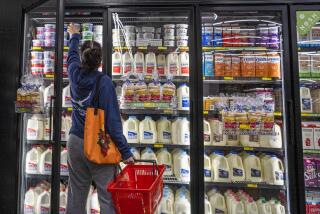Consumer Prices Rise 0.4% as Dollar Value Continues to Fall : Increasing Cost of Imports, Gasoline Fuels Inflation
- Share via
WASHINGTON — Consumer prices--reflecting increases for energy and a wide range of other goods--rose a hefty 0.4% in February, the government reported today, as evidence mounted that inflation has returned to haunt American pocketbooks after all but disappearing in 1986.
The rise in the Labor Department’s consumer price index followed a 0.7% surge in January. So far this year, consumer prices have increased at an annual rate of 6.7%--compared to the 1.1% rise for all of last year.
Economists said the February increase was, in part, a direct reflection of higher import prices stemming from declines in the value of the dollar against foreign currencies.
Energy Prices a Factor
Higher energy prices were also a factor in the February increase, but not to the extent that they had been the month before.
Gasoline prices were 4.2% higher at the pump in February than they were the month before, after rising 6.6% from December to January. Heating oil prices were up 4.4%, following a 9.8% rise in January.
The gains in gasoline and fuel oil prices accounted for roughly one-third of the overall February rise. Excluding energy, consumer prices increased 0.3% in February after a 0.5% rise in January.
Food prices, meanwhile, increased 0.3% after a 0.4% gain the month before. Grocery prices were up 0.4% while restaurant meal prices rose 0.2%.
Auto Prices Fall
Housing costs, up a sharp 0.5% in January, advanced 0.4% in February.
Meanwhile, in one of the few decreases recorded last month, new automobile prices fell 1.1%, a decline largely reflecting renewed manufacturers’ incentive programs. Car prices had risen 0.4% in January.
Auto financing charges also were down, by 2.5%.
“Anybody who thought inflation was a thing of the past was wrong,” said Bruce Steinberg, senior economist for Merrill Lynch Economics in New York. “Last year was the exception.”
Steinberg predicted a moderating trend in inflation later in the year, however, projecting that consumer prices will rise about 4.5% over the course of the year.
‘Low Inflation Over’
“I think what we saw in February was pretty close to the underlying inflation rate,” added Lawrence Chimerine, president of Chase Econometrics of Bala Cynwyd, Pa. “The low inflation we had in 1986 is over. We’re somewhere close to a 4% inflation range.”
But Michael K. Evans of Evans Economics Inc. predicted flatly: “Inflation is going to be 5% this year. . . . We’re finally beginning to see the effect the lower dollar is having on consumer prices.”
Although the dollar has fallen more than 40% against the Japanese yen since its peak in February, 1985, these changes were apparent only recently in the prices of Japanese goods sold in this country.
Economists said this generally is because Japanese manufacturers swallowed some of their profit margins to keep their share of lucrative U.S. markets.
However, with the dollar having fallen so far, prices of Japanese and European goods are beginning to inch upward month by month, analysts say.
More to Read
Inside the business of entertainment
The Wide Shot brings you news, analysis and insights on everything from streaming wars to production — and what it all means for the future.
You may occasionally receive promotional content from the Los Angeles Times.









